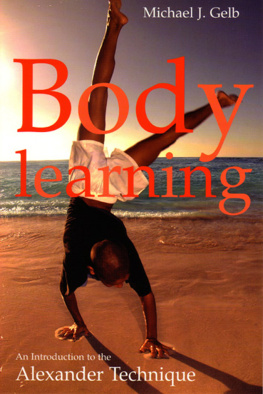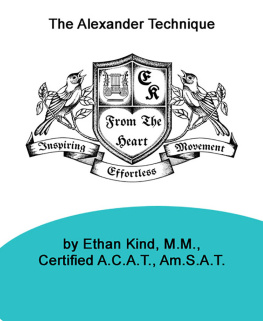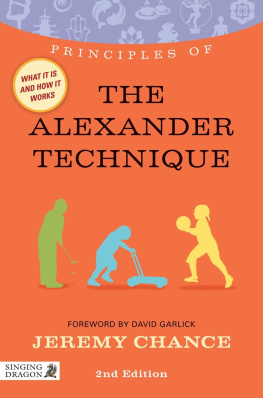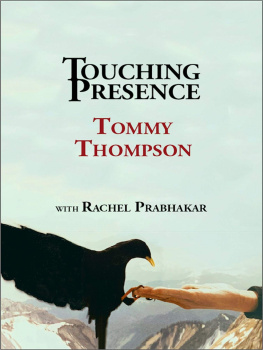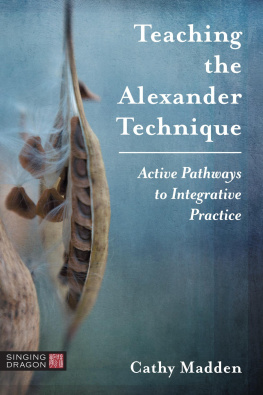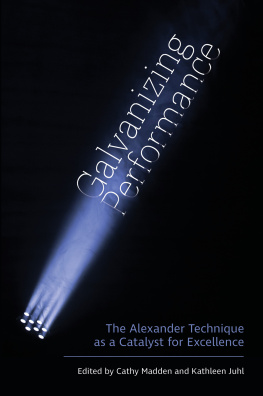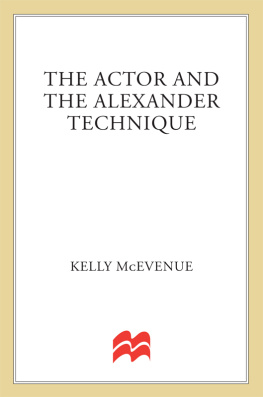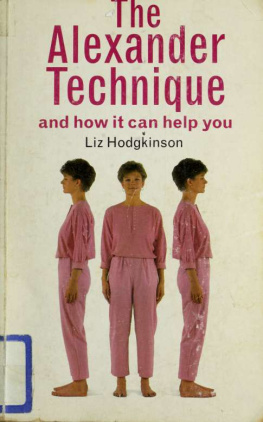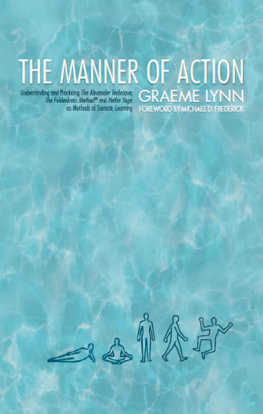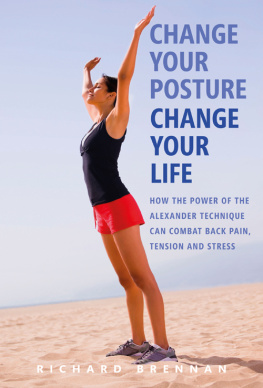Playing with Posture
Positive Child Development using the Alexander Technique
by
Sue Holla day
First p ublished in 2012 by HITE
HITE Limited, 10 Harley Street, London W1G 9PF
Email: info@hiteltd.co.uk
Website : www.hiteltd.co.uk
Copyright 2012 Sue Holladay
The right s of Sue Holladay
to be identified as the author of this work
have been asserted in accordance with
the Copyright, Design and Patents Act 1988.
All rights reserved. No part of this publication may be reproduced, stored in a retrieval system or transmitted in any form or by any means, electronic, mechanical, photocopying, recording or otherwise, without the prior written permission of the publisher.
A CIP catalogue for this book is available from the British Library.
Book and cover design by Nalini Thapen
ISBN: 978-0-9568997-2 -

Note to r eaders
This book con veys the opinions and ideas of its author. It is sold with the understanding that neither the author nor the publisher are providing medical advice . If the reader has any concerns, or requ ires advice, a doctor should be consulted.
The idea s and games outlined in this book may not be suitable for every one , and are not guaranteed to produce any particular results. The reader will gain most benefit from reading alongside having lessons with a qualified Alexander Technique teacher.
B oth the author and publisher specifically disclaim any responsibility for any liability, loss or risk, personal or otherwise, which is incurred as a consequence, directly or indirectly, of use and application of any of the contents of this book.
Some names and identifying details of the individuals mentioned in this book have been changed to protect their privacy .
If you would like to contact the author or publisher with any comments, requests, or suggestion, then please email: info@hiteltd.co.uk
To my three children, Oliver, Nicholas, Lucilla ,
and six grandchildren,
who have led me along this delightful and rewarding path of learning,
with my love and thanks.
C ontents
Foreword
Introduction
Searching for ideal posture
Posture is conditioned by habitual movement
Why the Alexander Technique is unusual
Education and positive child development
Can the Alexander Technique help your child
Foundations
Alexander Technique origins and now
Building up integration
Concepts in the Alexander Technique
Not so common sense
Indirect means
Alexander thinking
Alexander and positive child development
Stages of development
Early years
Primary years
Secondary years
Mapping the body
Eliminate strain
Increase freedom
Body Mapping
Importance of head balance
Importance of breathing
The back and limbs
How it all goes wrong
Reset and restore
Releasing the spine
Lying down the Alexander way
Waiting time
Putting it into practice
Listening and communicating
Internal discipline
Sensitivity to touch
Keeping mind and body in step
Thinking in action
The daily round
Standing the plumb line test
Lifting with leverage
Sitting in an armchair
Lying in bed
Dealing with stress
Integration your mindset
Reminders for thinking in action
School life
Sport and fitness
Music, dance and drama
Arts and crafts
Special needs
The home environment
Support and nourishment
Rhythm
Play
Joy
Conclusion
Appendix 1: Games to play with children
Appendix 2: Scientific Support
Acknowledgements
References
Foreword
Sue brings to this work the same quality of lightness of being, playfulness and delight that I experienced from her teaching when I began my own journey with the Technique some 12 years ago. My first encounter with the Alexander Technique had been through musicians describing the greater ease with which they created sound. As a violinist (albeit amateur), I was intrigued. Subsequently, in my role as a chiropractor, I question ed the use of external functional appliances to correct or optimize the mechanics of the foot and temporo - mandibular joints , and I began taking lessons myself.
With this experience I recall observing that primary school children would benefit if the teaching of the Technique were part of their formal learning experience. Over the years this instinct has been borne out as I have observed the benefits in children of all ages who have taken lessons. There are, of course, the direct and more tangible benefits of effortlessly making a fuller sound when playing a musical instrument , or improvements in co-ordination . M ore profoundly, the ease with in the body that they develop seems to help the se individual s navigate the challenges of transitional periods in their lives , or what we might call rites of passage , like puberty.
However Playing with Posture has a far broader scope. The book excels at communicating the essence of the Alexander Technique in such a way that is very readable and also highly kin a esthetic - immediately I read the directions ...
Let the neck be free
To l et the head go forward-and- up,
To l et t he back, lengthen and widen,
And let the knees go forward-and-awa y
... I feel my body responding! Head forward and up, back opening and I notice that I carry this reawakened awareness with me in all the normal comings and goings that make up my day. What a joyful, peaceful and delightful space this is! Its a place from which there is space to chose my perspective in any given moment. I particu larly like Sues short form, Stop, Think, A ct , as I feel its a useful translation of the directions both for those who have not yet had the experience of one-to- one A lexander T echnique lessons and for those who have . I t shortens the directions to a form tha t both children and adults can very easily integrate into their lives making all the benefits of being truly present in ones body , and therefore present in all activities, accessible in a new way.
When I recommend patients take A lexander T echnique lessons it can be a challenge to convey the essence and therefore value of the Alexander T echnique in a way that makes the potential benefit s meaningful to an individual. This book easily and clearly communicates this message by demonstrating its applicability to the everyday , through examples of activities and tasks that most people can relate to , such as pushing a super market trolley, sitting at a desk or washing-up. The inclusion of games for parents and teachers to play with children provides ample opportunities fo r practical exploration and fun.
The author brings to this work the unique combination of the authority of a teacher who has a wealth of experience in many different contexts and a compassionate unders tanding of the human condition - our lapses, our forgetfulness as we fall into old patterns of postural strain and compromise. The material is readable and accessible through the sharing of personal experience and the lightnes s of approach. Those slouching postural tendencies are explained when we understand that too much tension in one muscle group pulls us into a place of compromise. As we comprehend the roots to such patterns we can let go of the idea that it is about laziness and then there is room for a different choice , b eginning with freeing the neck, breakthrough!
Neuro - developmental delay and the remediation of persistent primitive reflexes is an area of special interest in my work with children. Sally Goddard-Blyth has been profoundly important to the area as a whole and to my personal practice and references to her work within this book give further validation to Playing with Posture. I have observed some of the most rewarding and dramatic results as the retained reflexes are inhibited , allowing age appropriate neurological development to be restored and completed. It is an area of work that is huge in terms of positive consequences for the individuals enabling them to reach their full potential . It is also an area which , despite compelling evidence , continues to be largely neglected at huge cost to individuals and their families with the consequent implications f or society as a whole. I t is particularl y gratifying that this topic is covered in a straight forward and encouraging manner in this book and in such a way that the material will be relevant to parents, teachers , both mainstream and special needs , and to the wider field of health practitioners.


